Matthieu Wyart
On the Emergence of Linear Analogies in Word Embeddings
May 24, 2025Abstract:Models such as Word2Vec and GloVe construct word embeddings based on the co-occurrence probability $P(i,j)$ of words $i$ and $j$ in text corpora. The resulting vectors $W_i$ not only group semantically similar words but also exhibit a striking linear analogy structure -- for example, $W_{\text{king}} - W_{\text{man}} + W_{\text{woman}} \approx W_{\text{queen}}$ -- whose theoretical origin remains unclear. Previous observations indicate that this analogy structure: (i) already emerges in the top eigenvectors of the matrix $M(i,j) = P(i,j)/P(i)P(j)$, (ii) strengthens and then saturates as more eigenvectors of $M (i, j)$, which controls the dimension of the embeddings, are included, (iii) is enhanced when using $\log M(i,j)$ rather than $M(i,j)$, and (iv) persists even when all word pairs involved in a specific analogy relation (e.g., king-queen, man-woman) are removed from the corpus. To explain these phenomena, we introduce a theoretical generative model in which words are defined by binary semantic attributes, and co-occurrence probabilities are derived from attribute-based interactions. This model analytically reproduces the emergence of linear analogy structure and naturally accounts for properties (i)-(iv). It can be viewed as giving fine-grained resolution into the role of each additional embedding dimension. It is robust to various forms of noise and agrees well with co-occurrence statistics measured on Wikipedia and the analogy benchmark introduced by Mikolov et al.
Bigger Isn't Always Memorizing: Early Stopping Overparameterized Diffusion Models
May 22, 2025Abstract:Diffusion probabilistic models have become a cornerstone of modern generative AI, yet the mechanisms underlying their generalization remain poorly understood. In fact, if these models were perfectly minimizing their training loss, they would just generate data belonging to their training set, i.e., memorize, as empirically found in the overparameterized regime. We revisit this view by showing that, in highly overparameterized diffusion models, generalization in natural data domains is progressively achieved during training before the onset of memorization. Our results, ranging from image to language diffusion models, systematically support the empirical law that memorization time is proportional to the dataset size. Generalization vs. memorization is then best understood as a competition between time scales. We show that this phenomenology is recovered in diffusion models learning a simple probabilistic context-free grammar with random rules, where generalization corresponds to the hierarchical acquisition of deeper grammar rules as training time grows, and the generalization cost of early stopping can be characterized. We summarize these results in a phase diagram. Overall, our results support that a principled early-stopping criterion - scaling with dataset size - can effectively optimize generalization while avoiding memorization, with direct implications for hyperparameter transfer and privacy-sensitive applications.
Learning curves theory for hierarchically compositional data with power-law distributed features
May 11, 2025Abstract:Recent theories suggest that Neural Scaling Laws arise whenever the task is linearly decomposed into power-law distributed units. Alternatively, scaling laws also emerge when data exhibit a hierarchically compositional structure, as is thought to occur in language and images. To unify these views, we consider classification and next-token prediction tasks based on probabilistic context-free grammars -- probabilistic models that generate data via a hierarchy of production rules. For classification, we show that having power-law distributed production rules results in a power-law learning curve with an exponent depending on the rules' distribution and a large multiplicative constant that depends on the hierarchical structure. By contrast, for next-token prediction, the distribution of production rules controls the local details of the learning curve, but not the exponent describing the large-scale behaviour.
Scaling Laws and Representation Learning in Simple Hierarchical Languages: Transformers vs. Convolutional Architectures
May 11, 2025Abstract:How do neural language models acquire a language's structure when trained for next-token prediction? We address this question by deriving theoretical scaling laws for neural network performance on synthetic datasets generated by the Random Hierarchy Model (RHM) -- an ensemble of probabilistic context-free grammars designed to capture the hierarchical structure of natural language while remaining analytically tractable. Previously, we developed a theory of representation learning based on data correlations that explains how deep learning models capture the hierarchical structure of the data sequentially, one layer at a time. Here, we extend our theoretical framework to account for architectural differences. In particular, we predict and empirically validate that convolutional networks, whose structure aligns with that of the generative process through locality and weight sharing, enjoy a faster scaling of performance compared to transformer models, which rely on global self-attention mechanisms. This finding clarifies the architectural biases underlying neural scaling laws and highlights how representation learning is shaped by the interaction between model architecture and the statistical properties of data.
How compositional generalization and creativity improve as diffusion models are trained
Feb 17, 2025



Abstract:Natural data is often organized as a hierarchical composition of features. How many samples do generative models need to learn the composition rules, so as to produce a combinatorial number of novel data? What signal in the data is exploited to learn? We investigate these questions both theoretically and empirically. Theoretically, we consider diffusion models trained on simple probabilistic context-free grammars - tree-like graphical models used to represent the structure of data such as language and images. We demonstrate that diffusion models learn compositional rules with the sample complexity required for clustering features with statistically similar context, a process similar to the word2vec algorithm. However, this clustering emerges hierarchically: higher-level, more abstract features associated with longer contexts require more data to be identified. This mechanism leads to a sample complexity that scales polynomially with the said context size. As a result, diffusion models trained on intermediate dataset size generate data coherent up to a certain scale, but that lacks global coherence. We test these predictions in different domains, and find remarkable agreement: both generated texts and images achieve progressively larger coherence lengths as the training time or dataset size grows. We discuss connections between the hierarchical clustering mechanism we introduce here and the renormalization group in physics.
Probing the Latent Hierarchical Structure of Data via Diffusion Models
Oct 17, 2024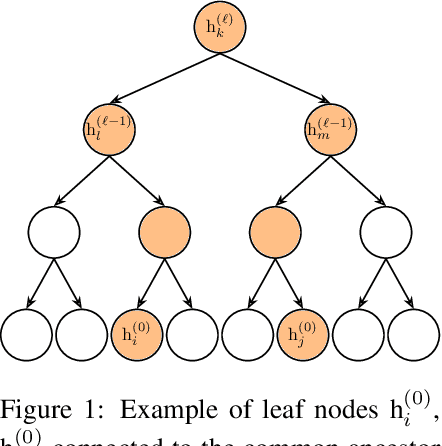
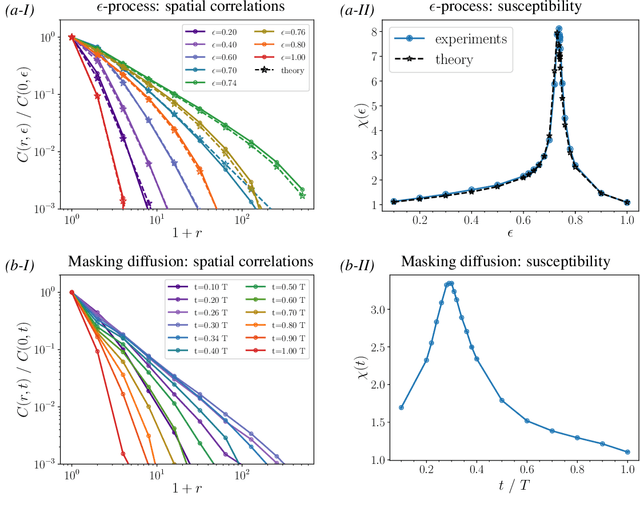

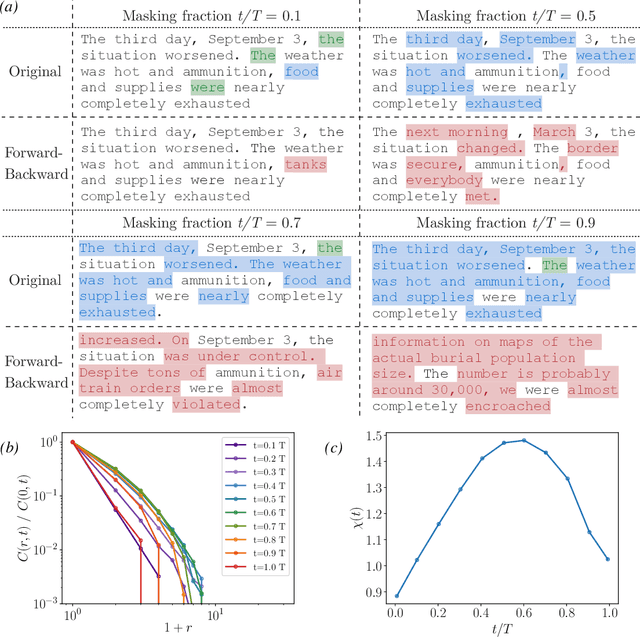
Abstract:High-dimensional data must be highly structured to be learnable. Although the compositional and hierarchical nature of data is often put forward to explain learnability, quantitative measurements establishing these properties are scarce. Likewise, accessing the latent variables underlying such a data structure remains a challenge. In this work, we show that forward-backward experiments in diffusion-based models, where data is noised and then denoised to generate new samples, are a promising tool to probe the latent structure of data. We predict in simple hierarchical models that, in this process, changes in data occur by correlated chunks, with a length scale that diverges at a noise level where a phase transition is known to take place. Remarkably, we confirm this prediction in both text and image datasets using state-of-the-art diffusion models. Our results show how latent variable changes manifest in the data and establish how to measure these effects in real data using diffusion models.
Could ChatGPT get an Engineering Degree? Evaluating Higher Education Vulnerability to AI Assistants
Aug 07, 2024
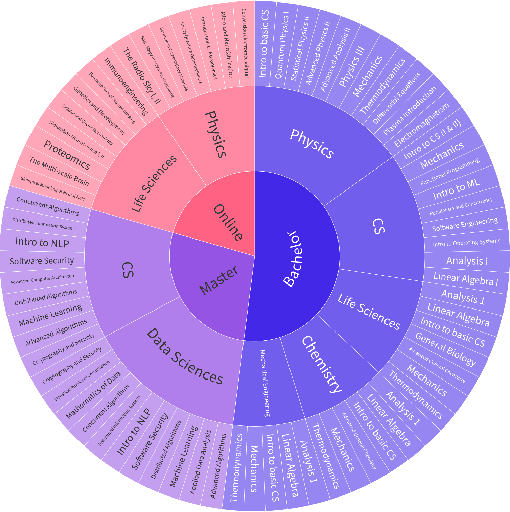
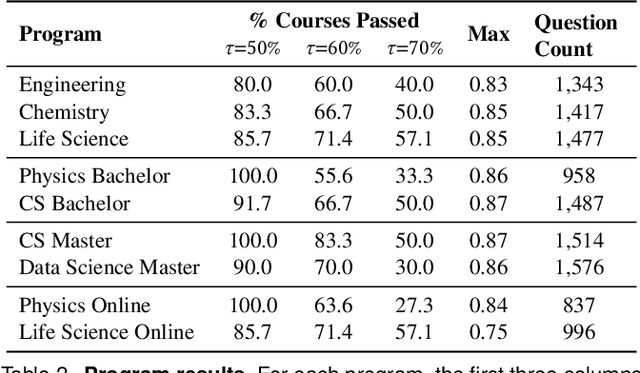

Abstract:AI assistants are being increasingly used by students enrolled in higher education institutions. While these tools provide opportunities for improved teaching and education, they also pose significant challenges for assessment and learning outcomes. We conceptualize these challenges through the lens of vulnerability, the potential for university assessments and learning outcomes to be impacted by student use of generative AI. We investigate the potential scale of this vulnerability by measuring the degree to which AI assistants can complete assessment questions in standard university-level STEM courses. Specifically, we compile a novel dataset of textual assessment questions from 50 courses at EPFL and evaluate whether two AI assistants, GPT-3.5 and GPT-4 can adequately answer these questions. We use eight prompting strategies to produce responses and find that GPT-4 answers an average of 65.8% of questions correctly, and can even produce the correct answer across at least one prompting strategy for 85.1% of questions. When grouping courses in our dataset by degree program, these systems already pass non-project assessments of large numbers of core courses in various degree programs, posing risks to higher education accreditation that will be amplified as these models improve. Our results call for revising program-level assessment design in higher education in light of advances in generative AI.
Towards a theory of how the structure of language is acquired by deep neural networks
May 28, 2024Abstract:How much data is required to learn the structure of a language via next-token prediction? We study this question for synthetic datasets generated via a Probabilistic Context-Free Grammar (PCFG) -- a hierarchical generative model that captures the tree-like structure of natural languages. We determine token-token correlations analytically in our model and show that they can be used to build a representation of the grammar's hidden variables, the longer the range the deeper the variable. In addition, a finite training set limits the resolution of correlations to an effective range, whose size grows with that of the training set. As a result, a Language Model trained with increasingly many examples can build a deeper representation of the grammar's structure, thus reaching good performance despite the high dimensionality of the problem. We conjecture that the relationship between training set size and effective range of correlations holds beyond our synthetic datasets. In particular, our conjecture predicts how the scaling law for the test loss behaviour with training set size depends on the length of the context window, which we confirm empirically for a collection of lines from Shakespeare's plays.
How Deep Networks Learn Sparse and Hierarchical Data: the Sparse Random Hierarchy Model
Apr 16, 2024



Abstract:Understanding what makes high-dimensional data learnable is a fundamental question in machine learning. On the one hand, it is believed that the success of deep learning lies in its ability to build a hierarchy of representations that become increasingly more abstract with depth, going from simple features like edges to more complex concepts. On the other hand, learning to be insensitive to invariances of the task, such as smooth transformations for image datasets, has been argued to be important for deep networks and it strongly correlates with their performance. In this work, we aim to explain this correlation and unify these two viewpoints. We show that by introducing sparsity to generative hierarchical models of data, the task acquires insensitivity to spatial transformations that are discrete versions of smooth transformations. In particular, we introduce the Sparse Random Hierarchy Model (SRHM), where we observe and rationalize that a hierarchical representation mirroring the hierarchical model is learnt precisely when such insensitivity is learnt, thereby explaining the strong correlation between the latter and performance. Moreover, we quantify how the sample complexity of CNNs learning the SRHM depends on both the sparsity and hierarchical structure of the task.
A Phase Transition in Diffusion Models Reveals the Hierarchical Nature of Data
Mar 04, 2024



Abstract:Understanding the structure of real data is paramount in advancing modern deep-learning methodologies. Natural data such as images are believed to be composed of features organised in a hierarchical and combinatorial manner, which neural networks capture during learning. Recent advancements show that diffusion models can generate high-quality images, hinting at their ability to capture this underlying structure. We study this phenomenon in a hierarchical generative model of data. We find that the backward diffusion process acting after a time $t$ is governed by a phase transition at some threshold time, where the probability of reconstructing high-level features, like the class of an image, suddenly drops. Instead, the reconstruction of low-level features, such as specific details of an image, evolves smoothly across the whole diffusion process. This result implies that at times beyond the transition, the class has changed but the generated sample may still be composed of low-level elements of the initial image. We validate these theoretical insights through numerical experiments on class-unconditional ImageNet diffusion models. Our analysis characterises the relationship between time and scale in diffusion models and puts forward generative models as powerful tools to model combinatorial data properties.
 Add to Chrome
Add to Chrome Add to Firefox
Add to Firefox Add to Edge
Add to Edge